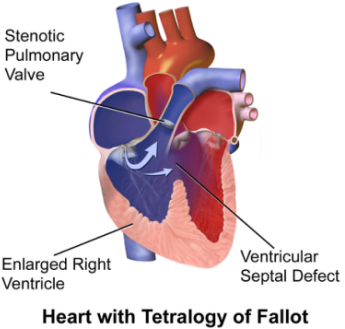Index
Tetralogy Of Fallot

What Is Tetralogy of Fallot (FAO)?
Is a type of heart defect present at birth and the most common complex congenital heart defect.
Symptoms at birth may vary from none for severe.
Later, there are typically episodes of bluish color to the skin known as cyanosis. When affected babies cry or have a bowel movement, they may develop a "Tet spells" where they turn very blue, have difficulty breathing, become limp, and occasionally lose consciousness.
Other symptoms may include a heart murmur, finger clubbing, and easy tiring upon breastfeeding.
What Causes Tetralogy of Fallot (TOF)?
Tetralogy of Fallot (TOF) is a combination of Four Defects
- Pulmonary stenosis.
- A large ventricular septal defect.
- An overriding aorta. With this defect, the aorta is located between the left and right ventricles, directly over the ventricular septal defect. As a result, oxygen-poor blood from the right ventricle can flow directly into the aorta instead of into the pulmonary artery.
- Right ventricular hypertrophy. In this case, the muscle of the right ventricle is thicker than usual because it has to work harder than normal.
- Are many causes is thought to be due to environmental or genetic factors or a combination. It is associated with chromosome 22 deletions and other more.
- Pulmonary stenosis.
- A large ventricular septal defect.
- An overriding aorta. With this defect, the aorta is located between the left and right ventricles, directly over the ventricular septal defect. As a result, oxygen-poor blood from the right ventricle can flow directly into the aorta instead of into the pulmonary artery.
- Right ventricular hypertrophy. In this case, the muscle of the right ventricle is thicker than usual because it has to work harder than normal.
- Are many causes is thought to be due to environmental or genetic factors or a combination. It is associated with chromosome 22 deletions and other more.

What are the Signs & Symptoms of
Tetralogy of Fallot (TOF)?
Tetralogy of Fallot results in low oxygenation of blood.
This is due to a mixing of oxygenated and deoxygenated blood in the left ventricle via the ventricular septal defect (VSD) and preferential flow of the mixed blood from both ventricles through the aorta because of the obstruction to flow through the pulmonary valve.
The latter is known as a right-to-left shunt. Infants with TOF -a cyanotic heart disease- have low blood oxygen saturation. Blood oxygenation varies greatly from one patient to another depending on the severity of the anatomic defects. Typical ranges vary from 60% to around 90%. Depending on the degree of obstruction, symptoms vary from no cyanosis or mild cyanosis to profound cyanosis at birth. If the baby is not cyanotic then it is sometimes referred to as a "pink tet".
Other symptoms include a heart murmur which may range from almost imperceptible to very loud, difficulty in feeding, failure to gain weight, retarded growth and physical development, labored breathing (dyspnea) on exertion, clubbing of the fingers and toes, and polycythemia.
The baby may turn blue with breast feeding or crying.
This is due to a mixing of oxygenated and deoxygenated blood in the left ventricle via the ventricular septal defect (VSD) and preferential flow of the mixed blood from both ventricles through the aorta because of the obstruction to flow through the pulmonary valve.
The latter is known as a right-to-left shunt. Infants with TOF -a cyanotic heart disease- have low blood oxygen saturation. Blood oxygenation varies greatly from one patient to another depending on the severity of the anatomic defects. Typical ranges vary from 60% to around 90%. Depending on the degree of obstruction, symptoms vary from no cyanosis or mild cyanosis to profound cyanosis at birth. If the baby is not cyanotic then it is sometimes referred to as a "pink tet".
Other symptoms include a heart murmur which may range from almost imperceptible to very loud, difficulty in feeding, failure to gain weight, retarded growth and physical development, labored breathing (dyspnea) on exertion, clubbing of the fingers and toes, and polycythemia.
The baby may turn blue with breast feeding or crying.
HEART CONDITIONS Diseases and Treated FAQ's
Congenital heart defects are now diagnosed with echocardiography, which is quick,
involves no radiation, is extremely specific, and can be done prenatally.
Echocardiography establishes the presence of TOF by demonstrating a VSD, RVH, and aortic override.
Many patients are diagnosed prenatally. Color Doppler (type of echocardiography) measures the degree of pulmonary stenosis. Additionally, close monitoring of the ductus arteriosus is done in the neonatal period to ensure that there is adequate blood flow through the pulmonary valve. Other studies can be applied according with the patient.
Echocardiography establishes the presence of TOF by demonstrating a VSD, RVH, and aortic override.
Many patients are diagnosed prenatally. Color Doppler (type of echocardiography) measures the degree of pulmonary stenosis. Additionally, close monitoring of the ductus arteriosus is done in the neonatal period to ensure that there is adequate blood flow through the pulmonary valve. Other studies can be applied according with the patient.
- Tet Spells
Tet spells may be treated with beta-blockers such as propranolol, but acute episodes require rapid intervention with morphine or intranasal fentanyl to reduce ventilatory drive, a vasopressor such as phenylephrine, or norepinephrine to increase systemic vascular resistance, and IV fluids for volume expansion.
- Total Surgical Repair
Total surgical repair of TOF is a curative surgery.
Different techniques can be used in performing TOF repair.
However, a trans-atrial, transpulmonary artery approach is used for most cases.
The repair consists of two main steps:
- - Closure of the VSD with a patch and
- - Reconstruction of the right ventricular outflow tract.
- Palliative Surgery
Initially surgery involved forming a side to end anastomosis between the subclavian artery and the pulmonary artery -i.e a systemic to pulmonary arterial shunt.
This redirected a large portion of the partially oxygenated blood leaving the heart for the body into the lungs, increasing flow through the pulmonary circuit, and relieving symptoms.
Tet spells may be treated with beta-blockers such as propranolol, but acute episodes require rapid intervention with morphine or intranasal fentanyl to reduce ventilatory drive, a vasopressor such as phenylephrine, or norepinephrine to increase systemic vascular resistance, and IV fluids for volume expansion.
- Total Surgical Repair
Total surgical repair of TOF is a curative surgery.
Different techniques can be used in performing TOF repair.
However, a trans-atrial, transpulmonary artery approach is used for most cases.
The repair consists of two main steps:
- - Closure of the VSD with a patch and
- - Reconstruction of the right ventricular outflow tract.
- Palliative Surgery
Initially surgery involved forming a side to end anastomosis between the subclavian artery and the pulmonary artery -i.e a systemic to pulmonary arterial shunt.
This redirected a large portion of the partially oxygenated blood leaving the heart for the body into the lungs, increasing flow through the pulmonary circuit, and relieving symptoms.